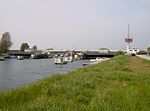Foteviken Museum
Archaeological museums in SwedenLiving museumsMuseums established in 1993Open-air museums in SwedenViking Age museums

The Foteviken Museum (Swedish: Fotevikens Museum) is an archaeological open-air museum on the Höllviken peninsula in southern Skåne, Sweden. It contains a reconstruction of a large Viking Age settlement and a "viking reservation", and visitors participate in living history reenactments; it also performs research and functions as the municipal museum of Vellinge Municipality and part of Fotevikens Kulturcenter, a group of cultural facilities on the peninsula.
Excerpt from the Wikipedia article Foteviken Museum (License: CC BY-SA 3.0, Authors, Images).Foteviken Museum
Museivägen, Vellinge kommun
Geographical coordinates (GPS) Address Phone number Website External links Nearby Places Show on map
Geographical coordinates (GPS)
| Latitude | Longitude |
|---|---|
| N 55.429280555556 ° | E 12.953138888889 ° |
Address
Fotevikens Museum (Fotevikens vikingamuseum)
Museivägen
236 51 Vellinge kommun
Sweden
Open on Google Maps






